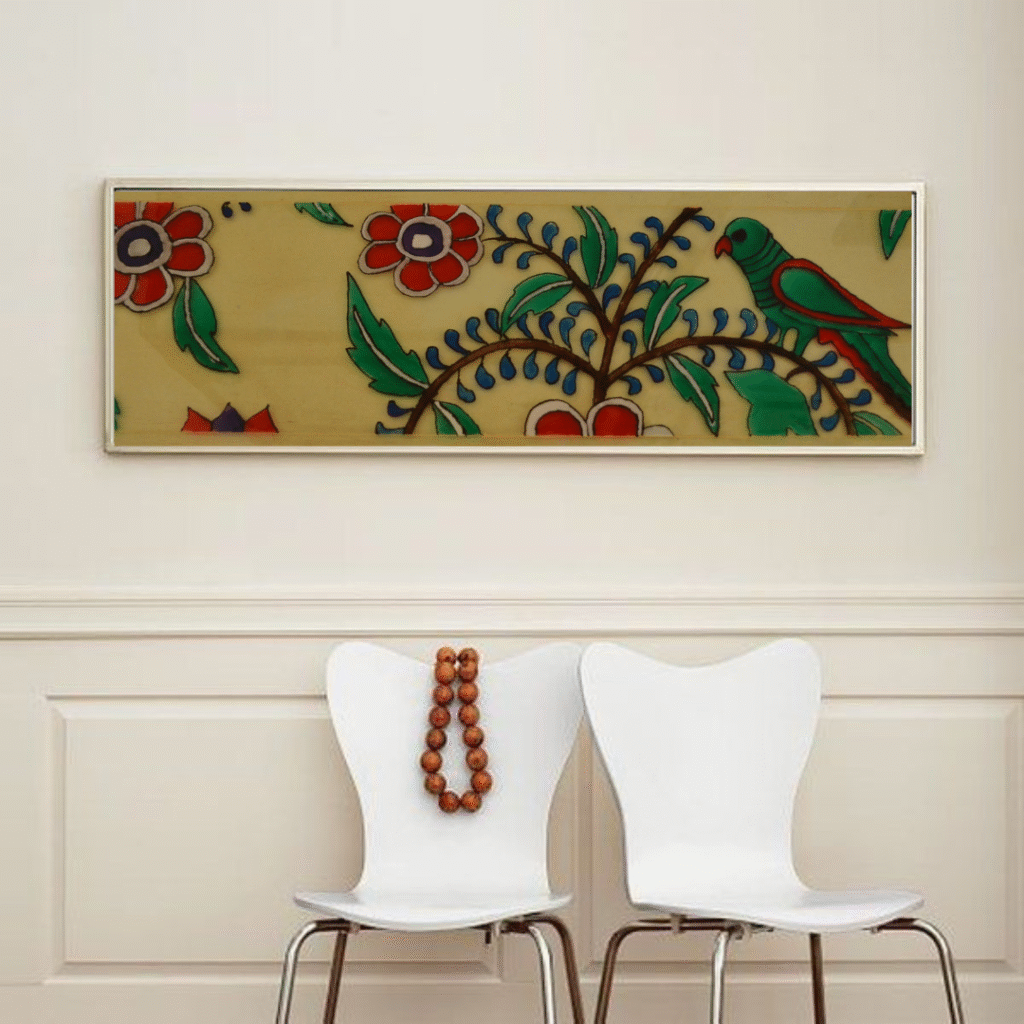
Glass painting is famous for its ability to combine translucence, colour, and light into breathtaking works of art. The Parrot glass painting presented here is a striking example of this tradition. Hence, capturing the vibrancy of nature through detailed floral motifs and the graceful depiction of a parrot. With its bold colors and elegant lines, this artwork reflects both the cultural depth and the artistic finesse of traditional glass craftsmanship.
At first glance, the viewer is drawn to the central elements of the design: blossoming red flowers surrounded by lush green leaves. Each petal is outlined with a crisp white border that accentuates the form. Therefore, making the colors stand out vividly against the pale, glassy background. The floral motifs are not merely decorative; they embody growth, life, and renewal. The red blossoms, with their deep hue and symmetrical patterns, lend the piece a sense of vitality and celebration, while the surrounding leaves add balance and a refreshing natural rhythm.
Why did I choose to make paintings on glass?
The parrot perched gracefully on the branch introduces a dynamic character to the painting. Rendered in shades of green with delicate red accents, the parrot appears both lifelike and symbolic. In many artistic traditions, parrots represent joy, communication, and a connection to nature. Here, its bright presence harmonizes with the surrounding flora, as though it is part of a vibrant ecosystem on glass. The careful detailing of its feathers and the tilt of its head showcase the painter’s skill in blending realism with ornamental style.
One of the most striking features of this glass painting is its use of color. The red, green, and blue tones are not simply painted but thoughtfully arranged to create contrast and depth. The drops of blue encircling the branches resemble seeds or raindrops, adding texture and flow to the composition. The interplay of these bold hues against the creamy background allows the artwork to radiate a luminous quality. Especially, when viewed under light.
The craftsmanship lies not only in the choice of colors but also in the precision of linework. Each element whether a flower, a leaf, or the bird, has a very careful outline. Hence, creating a stained-glass effect that gives the painting structure and clarity. This technique ensures that the vivid colors remain distinct, while the composition retains its balance and harmony.
Beyond its aesthetic appeal, this painting also carries cultural undertones. Traditional Indian glass paintings often depict flora and fauna, symbolizing prosperity, beauty, and the interconnectedness of life. The parrot, frequently associated with love and devotion in Indian lore, combined with blossoming flowers, creates a scene that celebrates abundance and joy. It reflects the artist’s intent to not only showcase nature’s beauty but also to evoke emotions of warmth and festivity in the viewer.
Conclusion – Parrot glass painting
In conclusion, this glass painting stands as a testament to the timeless charm of traditional craftsmanship. Through its vibrant flowers, lush foliage, and the lively parrot, it weaves together a story of nature’s splendor. Every detail from the bold strokes of color to the delicate outlines reflects the patience and artistry invested in the piece. It is not just a decorative panel but a window into cultural heritage. This is where light and color merge to create art that continues to inspire awe.
